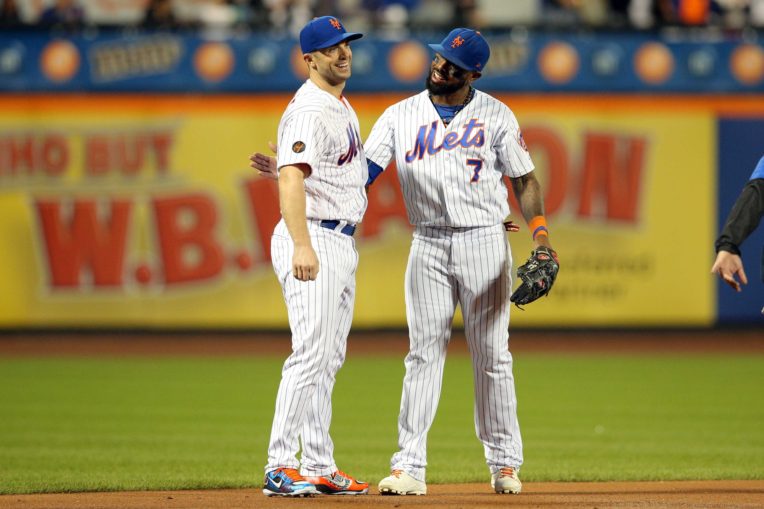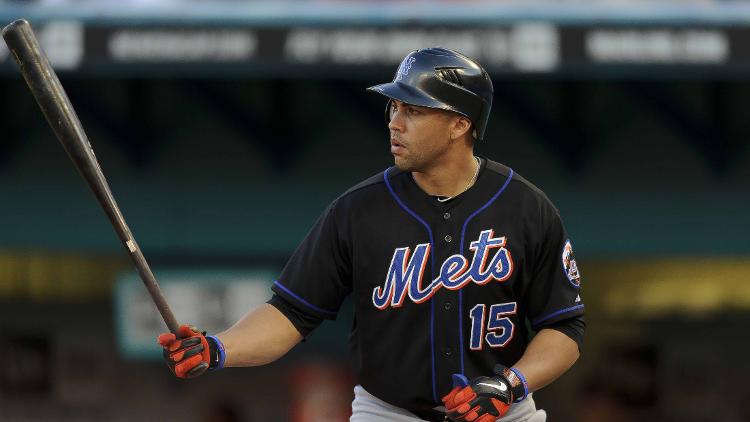
As spring training begins dwindling in exchange for Opening Day and baseball games that start to count, this is a prime time to truly start wondering the possibilities of the season ahead. We’ve been watching the New York Mets play games against other teams for a few weeks, meaning we at least have some kind of information to use as the basis for opinions.
After looking at how Brandon Nimmo and Michael Conforto could distinguish themselves in the outfield by both taking a step forward in 2019, I was curious as to the best single-season performances at each position in franchise history. Using fWAR as the benchmark, here is that hypothetical squad.
Catcher: Gary Carter, 6.7 fWAR in 1985
Stats: .281/.365/.488 line, 32 home runs, 100 RBI, 83 runs scored
When looking strictly at offensive stats, Mike Piazza‘s 2000 season (.324/.398/.614 with 38 homers and 113 RBI) seems to be superior to Carter’s debut in Flushing. However, it was the Kid’s defense that gives him an edge of nearly one 1.0 fWAR. In that area, Carter (16.3 Defensive Rating, per FanGraphs) is far superior to Piazza (5.3).
The 1985 season was significant for him because it was the second of three straight 100-plus RBI campaigns, and the 32 homers he hit was a single-season career high. While that was the most valuable he was from a pure numbers standpoint (6.1 combined fWAR from 1986-89), we all know how important he was to the fabric of this franchise.
It’s also worth noting that Piazza lands on the single-season best performances by a Mets catcher a total of four times (every season from 1999 through 2002).
First Base: John Olerud, 8.1 fWAR in 1998
Stats: .354/.447/.551 line, 22 homers, 93 RBI, 91 runs scored
Although Olerud’s .354 average wasn’t good enough to snag his second career batting title (Larry Walker hit .363 that year), the first baseman did set a franchise record. Always known for his ability to put his bat on the baseball, Olerud’s walk rate increased in each of the three years he spent with New York (13.5% to 14.4% to 17.3%).
He wasn’t with the organization for a long period of time, but his presence is certainly felt. All three of his seasons are among the seven best in franchise history. He and Keith Hernandez are littered throughout the top 10 — Keith has four appearances in the top-eight spots. Also sneaking into the top 10 is Lucas Duda‘s 2015 season, when he was worth 3.2 fWAR off the strength of a 132 wRC+ and 27 homers.
Second Base: Edgardo Alfonzo, 6.4 fWAR in 2000
Stats: .324/.425/.542 line, 25 homers, 94 RBI, 109 RBI
When looking back, the keystone has historically been a weak spot for the Mets with regard to overall positional value. No New York second baseman had bested Ron Hunt‘s 3.0 fWAR all the way back in 1964. Only Felix Milan tied Hunt in 1973 before Fonzie came along.
Alfonzo owns the two best single-season performances by a Mets second baseman, and they came in consecutive seasons (1999 and 2000). The ’00 campaign was his best from an overall offensive standpoint — his 150 wRC+ and .967 OPS were both career highs. He also paired that with a 14.6% walk rate (a career high) and a 10.8% strikeout rate.
Shortstop: Jose Reyes, 5.9 fWAR in 2008
Stats: .297/.358/.475 line, 16 homers, 68 RBI, 113 runs scored, 56 stolen bases
What happened at second base also took place at shortstop. Bud Harrelson put up 3.8 fWAR in 1971 thanks to his stellar defense (he had an 82 wRC+ and .303 slugging percentage). That number was the best for a Mets shortstop in a single year for nearly four decades before Jose Reyes came around.
He first broke the record in 2006 (5.7 fWAR) and nearly broke it again in 2007 (5.6) before breaking it again in 2008 (5.9) and hitting that same number in 2011 when he won the National League batting title. That ’08 campaign was also significant because it was the fourth straight year in which he played in at least 153 games. It happened once more in his career, and it was during his sole season with the Miami Marlins (160 games played in 2012).
Of Reyes’ 16 homers in ’08 (second-most during a single season for his career), 13 came via fly balls. That’s interesting because he posted just a 67 wRC+ for this specific batted-ball event, which was also accompanied by a 30.3% soft-hit rate and 20.5% hard-hit rate.
Third Base: David Wright, 8.4 fWAR in 2007
Stats: .325/.416/.546 line, 30 homers, 107 RBI, 113 runs scored, 34 stolen bases
No shock that the Captain takes the top spot here, right? This is one of five instances in which he appears in the top 10. It’s really unfortunate that the best year of David Wright’s career took place during such an excruciating late-season collapse. Although he probably doesn’t take any solace in his individual performance, he racked up the accolades.
The 2007 campaign was Wright’s only 30-30 season, along with the first of two consecutive years in which he captured a Gold Glove and Silver Slugger. He finished fourth in NL MVP voting, which was his second of three straight top-10 finishes.
Possibly the most interesting is how Wright didn’t wilt under the pressure of the Mets’ collapse — he actually got stronger over the season’s final two months. His September performance included a .352/.432/.602 triple slash with six homers, 20 RBI, and 21 runs scored in 125 plate appearances.
Left Field: Bernard Gilkey, 7.6 fWAR in 1996
Stats: .317/.393/.562 line, 30 homers, 117 RBI, 108 runs scored, 17 stolen bases
The 1996 Mets weren’t good — their 71-91 record was the organization’s sixth consecutive losing season in the ’90s — but there were some interesting players to follow, with one being Bernard Gilkey. His performance in 1996 is significant for all the obvious reasons, but he also broke through what had been a long-standing glass ceiling.
Prior to Gilkey, the two best single-season performances by a Mets right fielder belonged to Cleon Jones (6.3 in ’69, 4.6 in ’71). Unfortunately, Gilkey regressed pretty hard after what was clearly a career year. Following the .955 OPS and 152 wRC+ he posted in ’96, the outfielder came back with a .755 OPS and 102 wRC+ in ’97, and marks of .646 and 77, respectively, in ’98 before finishing the year with the Arizona Diamondbacks.

Center Field: Carlos Beltran, 7.8 fWAR in 2006
Stats: .275/.388/.594 line, 41 homers, 116 RBI, 127 runs scored, 18 stolen bases
Carlos Beltran’s 2006 season is mostly remembered for the Adam Wainwright curveball he didn’t swing at in October, but there’s no way the Mets are even in that position without his body of work from that entire year. He tied the franchise single-season home-run record, went to his third All-Star Game, and won his first Gold Glove and Silver Slugger awards.
His fourth-place finish in NL MVP voting was the only top-10 finish of his career.
Beltran followed up that performance with another 7.3-fWAR season in 2008, immediately distinguishing himself among Mets outfielders by being the only player with not one, but two years of 7.0-plus fWAR. His 2007 performance (5.1 fWAR) gives him three of the six best centerfield performances in franchise history, too.
Right Field: Darryl Strawberry, 6.5 fWAR in 1990
Stats: .277/.361/.518 line, 37 homers, 108 RBI, 92 runs scored, 15 stolen bases
Strawberry found his way to the top of the Mets’ career homer leaderboard by being incredibly consistent. During his time in Flushing (1983-90), he never hit fewer than 26 homers, which included three years of at least 37 dingers in his final four years with New York.
He actually hit about 75% of his career homer total with the Mets. He slugged 28 bombs in 1991 with the Los Angeles Dodgers, but reached double digits just twice more before retiring in 1999 (11 in ’96 and 24 in ’98, both with the Yankees).
Starting Pitcher: Tom Seaver, 9.1 fWAR in 1971
Stats: 20-10 record, 1.76 ERA, 0.95 WHIP, 26.2% strikeout rate, 5.5% walk rate in 286.1 innings
Think about how ridiculous Jacob deGrom‘s 2018 campaign was last year. It’s crazy that his performance is just the third-best in franchise history when looking at fWAR. Dwight Gooden‘s 1985 season just barely beat him out (8.9 fWAR), but they’re both looking up to Tom Seaver.
The Franchise led baseball in ERA, WHIP, strikeouts per nine innings (9.1), and strikeouts (289) in 1971. Every number you see from this season (and most of his career) oozes dominance, but this is my favorite: his 21 complete games that year is a single-season career high. It’s not only one more than his total number of wins (20), but it’s also three more than the number of homers he allowed to opposing hitters (18).
Relief Pitcher: Armando Benitez, 3.1 fWAR in 1999
Stats: 4-3 record, 22 saves, 1.85 ERA, 1.04 WHIP, 41.0% strikeout rate, 13.1% walk rate in 78 innings
This is a surprising way to end, isn’t it? The only relievers that have even sniffed Armando Benitez’s 1999 fWAR both came in 2016: Addison Reed (2.5, second most), and Jeurys Familia (2.2, fifth most).
Walks had always plagued Benitez, and that wasn’t any different in ’99. Walks are a lot easier to stomach when they’re paired with a strikeout rate up above 40.0%, though. Unfortunately for the hard-throwing right-hander, this debut with the Mets was as good as things would get.
Over the following three full seasons with New York, his strikeout rate continually took a dip (34.9% to 29.1% to 28.7%), while his walk rate stayed above 12.5% for all but one year (9.1% in ’02). He did save 117 games between 2000-02, but his combined fWAR during this time (2.8) couldn’t even match what he produced in ’99.















